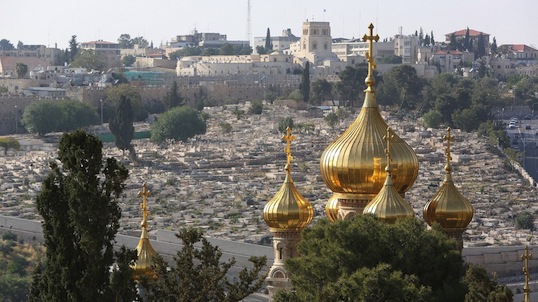
The Russian Orthodox Church of St. Mary Magdalene overlooking the massive and ancient Jewish cemetery on the Mount of Olives. (George Martell/TheGoodCatholicLife.com)
Fr. Daniel Moloney is Parochial Vicar at St. Columbkille Parish in Brighton in the Archdiocese of Boston. He is one of 29 priests joining Cardinal Seán O’Malley for a pilgrimage to the Holy Land between April 8 and April 15. We’ve asked him to share his experiences on their fourth full day in the Holy Land.
By Fr. Daniel P. Moloney
April 12
On Friday morning, we had a meeting with Bishop William Shomali, Auxiliary Bishop of the Latin Patriarchate of Jerusalem (the Patriarch himself was in Rome for a meeting with Pope Francis on Monday, so Bishop Shomali met with us instead). Six priests from our group processed out wearing their albs, plus a kind of cape that bore the Crusaders’ Cross. These were members of the Knights of the Holy Sepulchre: Fathers Jonathan Gaspar, William Dunn, Joseph Mazzone, Michael Medas, Daniel Hennessey, and Matthew Westcott. Because it was their first visit as Knights to the Holy Land, they received an official “Pilgrim’s Shell” (a pin in the shape of a shell). As Bishop Shomali explained, Pius IX established the Knights of the Holy Sepulchre in the mid-nineteenth century to support the Christian presence in the Holy Land with prayers and financial support, especially the schools and the parishes here. The priests are obviously counted on more for their spiritual support, while the lay members (a majority) are asked for financial support as well.
And the Church here needs our support. Only about 2% of the population here is Christian, about 400,000 people out of 17 million. There’s a danger that the presence of Christians here might diminish even more, and that this would be bad for the universal Church – it’s an important witness theologically that Christians live where Christ lived and died, and where the Church began.
Bishop Shomali shared with us several of the problems the Church faces in this Patriarchate. Some were common experiences that we see in Boston, too: he mentioned that many Catholics were cultural Catholics, who often proudly identify as Christian and want their children baptized, but who didn’t really have a personal encounter with Christ. But some challenges are particular to the Holy Land, especially the challenge of Ecumenical dialogue with the Orthodox Churches, and of inter-religious dialogue with Jews and Muslims.
These two challenges interact – it is hard to have a strong Christian witness to Jesus and Muslims when there are thirteen Christian Churches here, each with their own leader. Around the corner from the Latin Patriarch are the Greek Orthodox, the Greek Catholic, and the Armenian Orthodox Patriarchs, (a kind of “Patriarch’s Way”). This year the Roman Catholics in Jerusalem will celebrate Easter on the same day as the Orthodox do, according to the old Julian Calendar and not our modern Gregorian Calendar. This year, that’s May 5. Bishop Shomali says that having different dates for our most solemn feast day is a real point of division, and so, in Jordan (also part of the jurisdiction of the Patriarch, along with the Palestinian territories), they’ve celebrated Easter according to the Orthodox calendar for forty years. But Catholics in Jerusalem don’t like it – Roman Catholics are a majority in Jerusalem, and so don’t think they should change their Easter, especially when so many pilgrims show up for Holy Week expecting it to be at the same time as back home.
Cardinal Seán made the point that if there’s going to be any compromise on this front for the sake of unity, it’s going to have to come from the Catholic side, since we could adopt the date for Easter with a decision from the Pope, while it is politically difficult to get all their divided Churches on board. Bishop Shomali agreed, and then emphasized just how important it was to the Orthodox; in ecumenical conversations, the date of Easter comes across as something sacred, “like a dogma” – they will not change it.
When it comes to inter-religious dialogue, the problems are greater, and the stakes, at least politically, are higher. But despite being so small, the Church here plays an important function, says Bishop Shomali, as a “bridge” between Muslims and Jews. There is basically no dialogue directly between Muslims and Jews, and almost none that includes Christians, Muslims, and Jews together. So what conversations that do take place are between Muslims and Christians and then between Christians and Jews. Neither are easy, but the Bishop indicated those with Jews were farther along.
These dialogues, however difficult, follow the example of our Lord with the Roman Centurion and the Canaanite woman – which, the Bishop argued, made them Gospel imperatives, and therefore important.
Bishop Shomali asks all of us for our prayers. He particularly asked us to pray Psalm 122, “Pray for the Peace of Jerusalem”, and asked us to intensify our prayer for peace and unity in the Holy Land. May we all say to Jerusalem, and all who live therein, “Peace be to your homes, may peace reign in your walls … Peace!” (Psalm 122)
Cardinal Seán and a group of 29 priests of the Archdiocese of Boston have traveled on an Easter pilgrimage to the Holy Land this week, and they’re bringing the readers of TheGoodCatholicLife.com blog along with them.
All this week, our colleague George Martell is traveling with the pilgrimage, embedded with the Cardinal and his priests so we can bring you photos, blogs, videos, and audio reports from the Holy Land from the pilgrims at such places as the Basilica of the Annunciation, Mount Carmel, the Sea of Galilee, the Church of the Transfiguration, Qumran, the Mount of Olives, the Church of the Holy Sepulchre, the Upper Room, and more. This once in a lifetime opportunity to walk in the footsteps of Jesus with Cardinal Seán and the Archdiocese’s priests as an Easter retreat experience.
Please stay tuned to www.thegoodcatholiclife.com, as well as www.BostonCatholicPhotos.com and www.YouTube.com/BostonCatholic and our Facebook Page at www.facebook.com/bostoncatholic and Twitter account: www.twitter.com/bostoncatholic for the latest updates from the Holy Land.


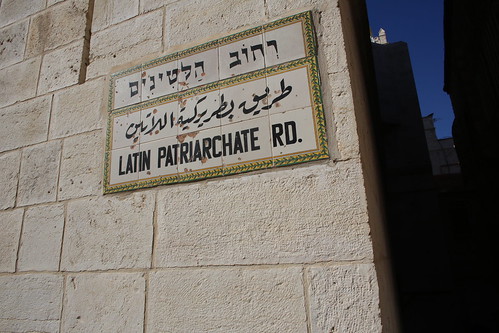


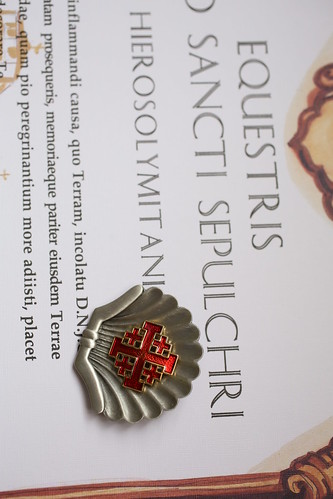
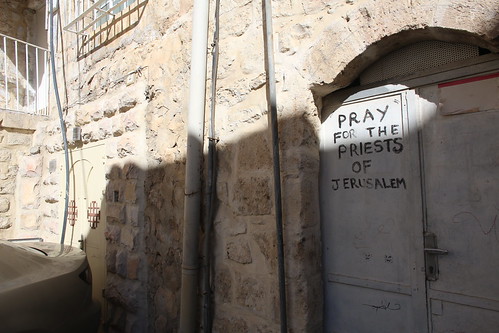

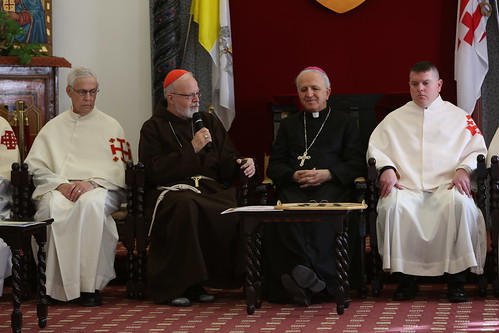

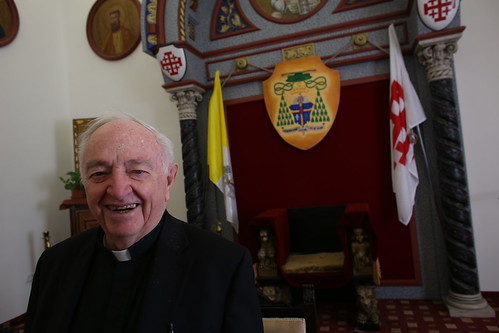
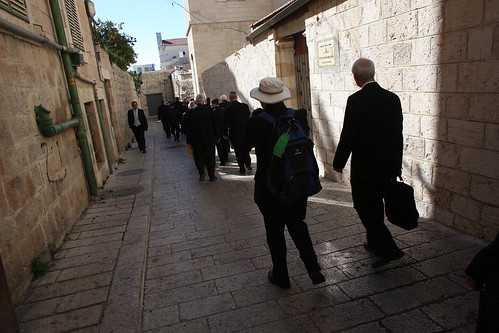
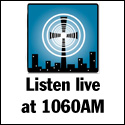
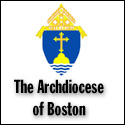

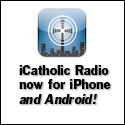

April 13, 2013 at 3:22 pm
Thank you Fr. Moloney for an excellent blog on the ecumenical and interreligious dialogue in the Holy Land.
The challenges seem great and I was surprised to learn that there are many “cultural Catholics” even in Israel.
How sad that people who live in the very places where Jesus lived, taught, suffered, died and rose again have never had a personal encounter with Christ.
August 6, 2013 at 3:47 am
Thanks for the nice article. Just thought I’d add a link to the the Halal Monk webproject, which collects the conversations of a Christian theologian with influential spiritual leaders and important artists of the Muslim world. I thought you and the readers of the blog might find it interesting as well.